|
 Marasmius atrocastaneus Marasmius atrocastaneus
BiostatusPresent in region - Indigenous. Endemic
Images (click to enlarge) | 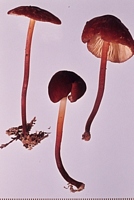
Owner: Herb. PDD | 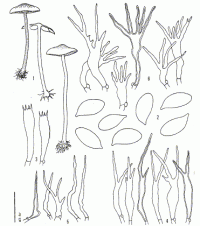
Caption: Fig. 14 (1-6). Marasmius atrocastaneus G. Stevenson (ZT 68-463).- 1. Basidiomes.- 2.
Basidiospores.- 3. Basidia.- 4. Cheilocystidia.- 5. Caulocystidia (x500).- 6. Pileipellis (X1000). | 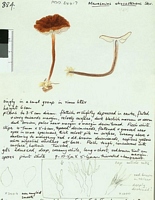
Caption: Watercolour
Owner: G.M. Taylor | 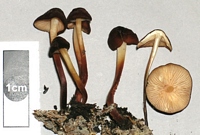
Owner: J.A. Cooper | 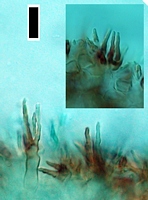
Caption: scale = 10um. Siccus type cap surface broom cells. Inset sicus type cheilocystidia
Owner: J.A. Cooper | 
Caption: ZT69-200
Owner: E. Horak: © Creative Commons Attribution-Noncommercial 3.0 New Zealand |
Article: Stevenson, G. (1964). The Agaricales of New Zealand: V. Kew Bulletin 19(1): 1-59.
Description: Pileus 1.5-4 cm diam., dark chestnut, intensely velvety, plano-convex with down-rolled margin, becoming plane; flesh tough, creamy yellow. Gills adnate, seceding, creamy yellow, moderately crowded. Stipe 2-4 cm x 3-4 mm, yellowish immediately beneath gills, then brownish orange to dark chestnut, velvety, tough, hollow. Spores 11-12 x 6 µm, non-amyloid, hyaline. Cuticle of pseudo-amyloid broom-cells with strongly pigmented fringes. Strong unpleasant smell.
Habitat: Bound with white mycelium to clumps of Nothofagus solandri litter, Butterfly, Wellington, 10.7.1949, Stevenson (type); Roding Valley, Nelson, 20.4.1957, E. B. Kidson.
Article: Desjardin, D.E.; Horak, E. (1997). Marasmius and Gloiocephala in the South Pacific Region: Papua New Guinea, New Caledonia, and New Zealand taxa. Bibliotheca Mycologica 168: 152 p.
Description: Pileus 15-25(-40) mm diam, convex to obtusely convex-umbonate when young, expanding with
age to plano-convex or plano-umbonate; disc radially wrinkled; margin non-striate, incurved and
remaining so in age; surface dull, dry, conspicuously velutinous; evenly deep brown with sooty
tones, dark chestnut, dark orangish brown or dark reddish brown. Texture membranaceous, tough;
context white to cream.- Lamellae adnexed to adnate, close (27-32) with 1-2 series of lamellulae,
broad (up to 3 mm), yellowish white to cream; edges fimbriate, reddish brown.- Stipe (20-)35-70
x 2-3(-4) mm, central, cylindrical, equal or gradually attenuated towards the apex, tough, hollow,
dry, pruinose to minutely velutinous overall, non-insititious, base covered with dense, yellowish
ochre mycelial strands or strigose hairs; apex cream to orange brown, grading to dark orangish
brown to dark brown towards the base; context orangish brown.- Odor and taste unpleasant,
weakly spermatic.
Basidiospores (9-)10-12 x 4.5-5.5 µm, ellipsoid to subfusoid, sometimes slightly curved in
profile, smooth, thin-walled, hyaline, inamyloid. - Basidia 24-36 x 6-8 µm , cylindrical to
subclavate, 4-spored, clamped. - Cheilocystidia common, of Siccus-type cells; main body 15-35 x
4-8 µm , cylindrical to subfusoid, moderately thick-walled (up to 0.5 µm), yellowish brown to
brown; apical setulae 2-30 x 2-3 µm , cylindrical to needle-shaped, acute, thin-walled to thick-walled, hyaline to pale reddish brown.- Pleurocystidia and hymenial setae absent. - Pileipellis
hymeniform, of Siccus-type cells; main body 15-35 x 5-10 µm, cylindrical to clavate or a
irregular in outline, sometimes forked, thin-walled to thick-walled, yellowish brown to brown;
apical setulae 5-25 x 1.0-2.5 µm, cylindrical to narrowly acute; or needle-shaped, thin-walled to
thick-walled, brownish; pilosetae absent. - Pi1eus trama dextrinoid-. Lame11ar trama with
oleiferous hyphae, weakly dextrinoid.- Stipe tissue monomitic; cortical hyphae cylindrical, thick-walled, orangish brown; medullary hyphae similar but thinner walled. - Cau1osetae common, 30-80 x 4-8 µm, fusoid, lanceolate or needle-shaped, sometimes branched, apex acute, firm-walled, orangish brown.- C1amp connections present.
Habitat: Habit, habitat and distribution.- Solitary,onleaflitterofNothofagus solandri (Holotype), or on
litter under Nothofagus fusca, N. menziesii, N. truncata (Fagaceae), Dacrydium cupressinum
(Podocarpaceae), and Metrosideros umbellata (Myrtaceae). New Zealand.
Notes: Diagnostic features of M. atrocastaneus include: a convex-umbonate, non-striate, conspicuously
velutinous, dark brown pileus; close, broad, cream-colored lamellae with reddish brown edges; a
dark orangish brown to brown, velutinous, non-insititious stipe; pileipellis cells and cheilocystidia
with very long, acute setulae; no pleurocystidia or hymenial setae; and abundant caulosetae. The
presence of caulosetae and Siccus-type pileipellis elements indicate placement in sect. Sicci, series
Atrorubentes. The New Zealand species appears most phenetically similar to M. umbrinus Pegler,
described from east Africa. Marasmius umbrinus differs in forming longer and narrower
basidiospores (11.5-15.0 x 3.3-4.8 µm), and Siccus-type caulocystidia with 1-8 apical setulae (fide
Pegler, 1977).
|